
by Rick O'Connor | Jul 19, 2024
In this series we have found that in the 1970s and 1980s climate scientists developed models that could predict the effects of a warming planet on society.
We saw that society, at that time, had little faith in the accuracy of those model predictions.
We also saw that natural occurring events, like tropical storms and the eruption of Mt. Pinatubo, gave climate scientists an opportunity to test their models – and their models past with flying colors.
We have seen the development of international councils and panels to address climate change, enhance the models, and provide advice on how to turn the potential negative effects of a warming planet around.
We have also seen that many of the predictions from those early models are occurring, some have occurred faster than the models indicated they would.
So…
Is there anything we can do about it?
The answer is pretty simple really. Just like those trying to lose weight – you need to either reduce the calories you take in and/or burn those calories off. With climate you need to reduce the amount of carbon you put into the atmosphere and/or remove the excess carbon.
In 2006 NASA climate scientists stated that we had about a decade to make some serious policy changes to avoid irreversible climate change that could cause economic and ecological havoc. They mentioned we needed to cut CO2 emissions between 50-85% by 2050. Their suggestions could be found on both sides of the solution model.
| Reducing Greenhouse Emissions |
Removing Greenhouse Gases |
| Cut fossil fuel use (especially coal) |
Add technologies to both smokestacks and combustible engines to remove CO2 in their emissions |
| Shift from coal to natural gas |
Sequester CO2 by planting trees |
| Improve energy efficiency |
Sequester CO2 underground |
| Use more renewable energy and make these technologies available in developing countries |
Use better land management practices in agricultural |
| Reduce deforestation |
Sequester CO2 in the deep ocean |
| Use more sustainable agriculture and forestry methods |
|
Other methods that could help reduce CO2 emission…
- Increase the fuel efficiency of our cars. One target had vehicles getting 60 mpg by 2057.
- Reduce the distance we drive each year. One target had no more than 5000 miles/year.
- Cut electricity use in homes and offices by 25%.
- Increase solar power use.
- Increase wind power use.
- Increase the use of biofuels.
- Stop deforestation.
- Better methods in agriculture.
- Install scrubbers in fossil fuel burning engines to clean emissions.
So… How are we doing with these?
Cars are more fuel efficient than they were decades ago. Many have turned to electric cars, or hybrids.
It seems that we are driving MORE miles each year – not less. Our society is designed around the need for an automobile – we cannot function without one. And our city planning seems to have us living farther and farther from our work. When I was younger there was much talk about mass transit to reduce traffic and emissions. In large cities where this was already ongoing it continues. But in the other parts of the county this has not really caught on. We are still driving too much.
There are methods of making homes more efficient. My wife and I adopted some of these as we rebuilt our house after a fire. Compared to neighbors and friends, our power bills are much lower. Many of these methods and technologies are being used in new home developments and are encouraging.
Solar farms are increasing – even along I-10 in the Florida panhandle. There is some concern that these solar farms are replacing food farms, but there is an attempt to do this. Out west we see the same.
The same can be said for wind farms – at least out west.
According to the U.S. Energy Information Administration, biofuel production has increased each year since 1980.
Deforestation has not slowed. As a matter of fact, many developments in the Florida panhandle begin by removing ALL trees. In some cases, they replace lost trees with saplings in the new neighborhoods. But a major source of carbon removal has been removed from the system. There is much more that needs to be done with this issue.
Speaking for the farmers in the Florida panhandle – yes… many have turned to better land management practices to protect their land and reduce, or sequester, carbon.
“Scrubber” in internal combustion engines is required by law in the U.S.
Despite some of these positive changes, carbon in our atmosphere continues to increase – not decrease. Part of this is because this is a global issue and that all of human society must work together to reduce greenhouse emissions. Some countries are doing better than others. There are international summits every few years to discuss what the world should do to tur the tide on climate. But all countries need to attend, particularly those producing the largest amount of greenhouse gases.
Here at home, there is resistance to reducing the use of fossil fuels, so many programs have not moved as far forward as they need to move. It is also important to understand that even with the behavior changes we seek, it will take time to undo the damage already done. We will not see improvement right away. Enacting new programs and technologies now could take over 100 years to see the impacts. It is important to understand that the longer we put changes off, the longer it will be before we see any positive benefits from those actions.
There is the concern that the political and public will is still not there to make these changes happen. But they will need to if we are to see things begin to improve.
Until then – you can do your part. Use fossil fuels as little and efficient has you can. Plant trees to help remove carbon dioxide and shade your house so you need less air conditioning. There are many other things you can do to help turn the tide on climate. Check with your local extension office for more ideas.


by Rick O'Connor | Jul 13, 2024
As I mentioned in Part 1, I taught environmental science in the 1990s and the first decade of the 21st century. Reviewing the textbook used for that course I provide information below that was taught at the time. The purpose of this series on Another Look at Climate Change is to see whether the predictions made at that time are occurring now. Part 3 – What Are Some Possible Effects…\
One question expressed in the 1990s, as it is today, is why we should be concerned about a few degrees change in temperature. Many at the time, and today, did not see the change of a few degrees any different than the change that occurred between the months of May and July. What’s the big deal? The response is that scientists were not looking at temperature changes over a short period of time, but over longer periods – and how rapidly they were changing. In the ancient past, the warming of the planet was over thousands to hundreds of thousands of years. It was now occurring over decades.
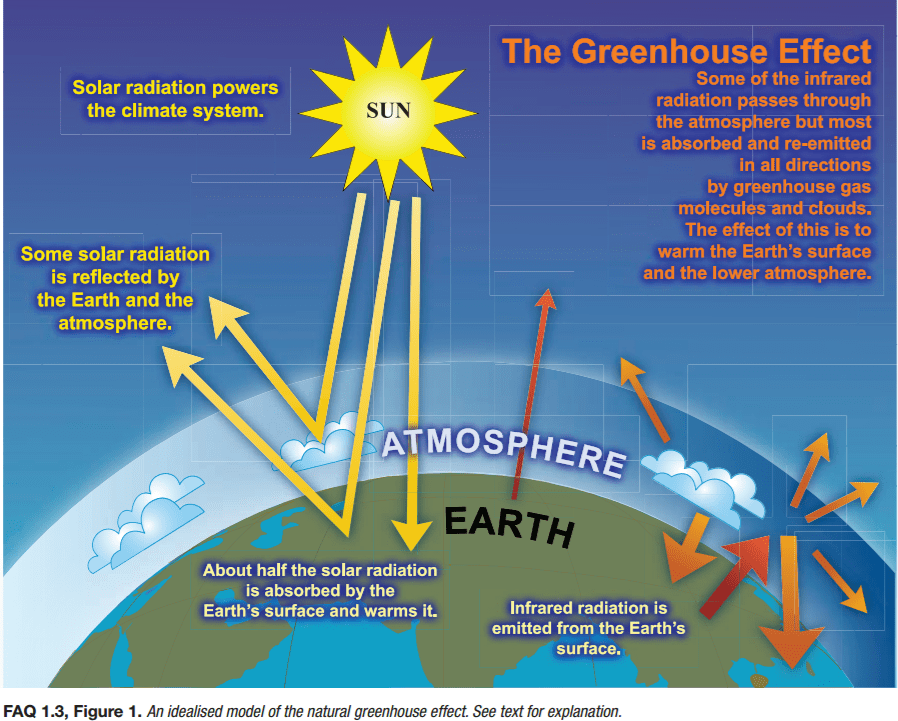
The greenhouse effect.
Image: NOAA
Climate models at the time were providing information on where food could be grown, how much could be grown, where droughts and flooding were going to increase, and where wildlife and people might have to live. And, due to the rapid change in temperatures, that we were going to have to deal with it during the next century.
In 2003 a U.S. National Academy of Sciences report provided a “worst-case scenario” of climate and ecological changes that may occur. It mentioned that we might reach an irreversible tipping-point and afterwards would not be able to reverse the effects for thousands of years. It described ecosystems collapsing, low-lying cities would flood, vast wildfires in the forests, grasslands drying out from prolonged droughts. As mountain glaciers melt, rivers that bring needed drinking water to many would dry up. There would be pre-mature extinction of up to half of the planet’s species, prolonged heat waves, increased flooding, more destructive storms, and the spread of tropical diseases beyond their current range.
NOTE: Many of these predictions continue to be discussed today – some are occurring.
The following lists were some of the predictions provided at the time. Do you see any that have occurred?
Effects if CO2 levels reach 450 ppm – NOTE: It was stated at that time that this was unavoidable.
- Forest fires will worsen.
- Prolonged droughts will intensify.
- Deserts will spread.
- Major heat waves become more common.
- Conflicts over water supplies increase.
- Modest increases in crop production in temperate regions.
- Crop yields fall by 5-10% in tropical Africa.
- Coral reefs affected by bleaching.
- Many glaciers melt faster and threaten water supplies for millions of people.
- Sea levels rise enough to flood lo-lying coastal areas – such as Bangladesh.
- More people exposed to malaria.
- High risk of extinction for Arctic species – such as the polar bear.
CURRENT UPDATES ON THESE PREDICTIONS…
- In 2024 the Western Fire Chiefs Association reported that though the number of annual wildfires has decreased since the 1990s, the area of land destroyed by wildfires has increased. In the 1990s there was an annual average of 3.3 million acres burned by over 78,000 wildfires in the U.S. Since 2000 a little over 70,000 wildfires have burned over 7 million acres a year. This is due to great fuel load due to drier/drought conditions largely caused by climate change.
- In 2023 two NASA scientists confirmed that droughts are becoming more frequent.
- In 2018 a study reported by the National Science Foundation confirmed that the Sahara Desert has expanded 10% since 1920.
- The U.S. EPA reported in 2023 that heat waves in major cities have increased from 2 a year in the 1960s to 6 a year during the 2010s and 2020s.
- The University of Southern California reported that conflicts between states over water supply from the Colorado River are occurring. Others indicate that, though nonviolent at this point, conflicts across the planet over water have begun.
- Climate change may negatively affect production of corn and wheat by 2030.
- Wheat grows well between 15° – 20°C. However, in sub-Sahara Africa temperatures already exceed this. It is believed that by 2030 wheat production will decrease by 10-20% from 1998-2002 yields.
- NOAA reported in 2024 that the world is currently going through a fourth coral bleaching event. Heat stressed bleaching has been a problem in both the northern and southern hemisphere.
- Recent evidence suggests that ancient glaciers are melting more than a quarter of a mile a day, which is faster than the models predicted.
- The annual frequency of high tide flooding in the U.S. has more than doubled since 2000 – and is predicted to triple by 2050.
- Although the risk of getting malaria in the U.S. is low, cases are increasing. Particularly in Florida and Texas.
- I could not find any reports of Arctic species that have gone extinct, but there are numerous reports of species endangered of it. One report stated that at the current rate of warming, polar bears could be extinct by the end of the century.
OTHER NOTES:
According to a 2005 study, between 1979 and 2002 the area of the earth’s land experiencing severe drought increased from 15% to 30%. The 2007 IPCC report predicted this increase would continue.
The 2021 IPCC report stated the same, the frequency increase will continue.
This “browning” of the earth will enhance other ecological problems such as reduced soil moisture that will impact plant growth rates, impacting their ability to remove CO2, enhancing warming, and causing some bodies of water to dry up and rivers enable to reach the sea.
The light color of snow and ice in the polar regions reflects solar radiation helping to cool the planet. The melting of this snow and ice – which is predicted / and is happening – will increase the absorption of solar radiation increasing warming. A 2006 NOAA report predicted arctic summers with no floating ice by 2040. Other studies suggest this will happen as early as 2013.
According to the 2007 IPPC report the average sea level is very likely (90-99% certainty) to rise 0.6-1.9 feet during this century. In 2022, global average sea level set a record high – 4 inches above the 1993 level… and the 2021 IPPC report stated that we have passed the tipping for sea level rise – it will rise no matter what we do. We are at a point that coastal communities need to begin planning for this. Predictions from that time on the affects of sea level rise include:
- Degradation or destruction of at least one third of the world’s coastal estuaries, wetlands, and coral reefs.
- Disruption of many of the world’s coastal fisheries.
- Flooding of low-lying barrier islands and erosion of gently sloping coastlines.
- Flooding of agricultural lowlands and deltas where rice is grown.
- Contamination of coastal freshwater aquifers with salt water – salt intrusion.
- Submergence of low-lying islands in the Pacific, Caribbean, and Indian Oceans.
- Flooding of coastal cities.
It is known that the amount of methane (a major contributor to greenhouse gases) locked in the permafrost is 50-60 times great than the amount released by burning fossil fuels. According to a 2004 study, 10-20% of the Arctic’s permafrost may thaw this century – enhancing warming. A 2024 report stated that 7% of the current permafrost has melted.
Ocean currents move CO2, warm and cold water across the planet regulating the climate. There was concern at the time that the melting of the poles (particularly Greenland) could introduce enough freshwater to alter these currents and impact the climates of northern Europe and northeastern North America. At the time, scientists did not see this as a threat in the near future.
The increase in extreme weather…
Heat waves, droughts, desertification, flash floods from prolonged rain could all happen…
At the time there was disagreement as to whether warming would increase the frequency and intensity of tropical storms and hurricanes. A 2008 study found that since 1950 for every 1°F increase in ocean temperature in the Atlantic, the number of hurricanes and tropical storms would increase by one third. It also showed that the number of hurricanes with wind speeds of 110 mph or greater increased by 45%. NASA stated since 1980 hurricane activity in the North Atlantic has increased but thus far much of this has been from natural climate variation. However, they did point out one study that showed evidence that the rapid intensification of these storms cannot be explained by natural climate variations and could be connected to climate change.
As the planet warmed it was predicted that ecosystems would shift and change. Some tropical species would disperse further north – tropicalization. We have witnessed the expansion of mangroves into the northern Gulf of Mexico. According to the 2007 IPCC report, about 30% of the land-based plants and animals could disappear. A 2019 United Nations article stated that the Intergovernmental Science-Policy Platform on Biodiversity and Ecosystem Services reported that the rate of extinction has accelerated. Warming was also predicted to disrupt biological clocks of migratory species and the Florida Museum of Natural History has already reported this is happening with migrating songbirds. Warming was also predicted to increase the populations of some species of insects and fungi that damage trees.
There were also predictions to the health of humans…
One will be the increased deaths due to heat waves. Others would be increased disease from insects and allergy issues from increased pollen. A 2024 U.S. Environmental Protection Agency report showed that human deaths related to heat waves has increased since 1979.
This snapshot gives us an idea of how well the computer models predicted the impacts of climate change and whether we should pay closer attention to what the current models are saying for the future. The 2021 IPPC report indicated that we have passed the tipping point for sea level rise and are approaching the tipping point for other possible impacts.
There has been talk about climate for a long time. Though many things are beginning to happen there is more our world can do to help reduce the risk of these possible impacts. In Part 4 of this series, we will look at what was suggested a decade ago and how we are doing with those.
References
Miller, G.T., Spoolman, S.E. 2011. Living in the Environment; Concepts, Connections, and Solutions. 16th Edition. Brooks and Cole. Belmont CA. 674 pp.
Are Wildfires Increasing or Decreasing in the U.S.? The Western Fire Chiefs Association. 2024. https://wfca.com/wildfire-articles/are-wildfires-increasing-or-decreasing-in-the-us/#:~:text=The%20amount%20of%20land%20burned,due%20to%20approximately%2078%2C600%20fires.
Cawdrey, K. 2023. Warming Makes Droughts, Extreme Wet Events More Frequent, Intense. NASA Explore. https://www.nasa.gov/centers-and-facilities/goddard/warming-makes-droughts-extreme-wet-events-more-frequent-intense/.
New Study Finds World’s Largest Desert, the Sahara, Has Grown By 10% Since 1920. National Science Foundation News. https://www.nsf.gov/news/news_summ.jsp?cntn_id=244804.
Climate Change Indicators: Heat Waves. 2023. U.S. Environmental Protection Agency. https://www.epa.gov/climate-indicators/climate-change-indicators-heat-waves#:~:text=Heat%20waves%20are%20occurring%20more%20often%20than,the%202010s%20and%202020s%20(see%20Figure%201).
The Water Wars of the Future are Here Today. The University of Southern California Today. https://today.usc.edu/the-water-wars-of-the-future-are-here-today/.
Gray, E. 2021. Global Climate Change Impact on Crops Expected Within 10 Years, NASA Study Finds. NASA Global Climate Change News. https://climate.nasa.gov/news/3124/global-climate-change-impact-on-crops-expected-within-10-years-nasa-study-finds/.
Munang, R., Andrews, J. 2014. Despite Climate Change, Africa can Feed Africa. Africa Renewal. https://www.un.org/africarenewal/magazine/special-edition-agriculture-2014/despite-climate-change-africa-can-feed-africa.
NOAA Confirms Fourth Coral Bleaching Event. 2024. NOAA News and Features. https://www.noaa.gov/news-release/noaa-confirms-4th-global-coral-bleaching-event.
Harvey, C. 2023. Glaciers May Melt Even Faster Than Expected, Study Finds. Scientific American Newsletter. https://www.noaa.gov/news-release/noaa-confirms-4th-global-coral-bleaching-event.
Rising Seas, Flooding Coasts. 2023. Climate Central. https://www.climatecentral.org/climate-matters/rising-seas-flooding-coasts-2023.
Malaria in the U.S. – Is Climate Change Affecting Disease Spread? 2023. Gavi. The Vaccine Alliance. https://www.gavi.org/vaccineswork/malaria-us-climate-change-affecting-disease-spread#:~:text=A%20warmer%20world%20means%20mosquitoes,as%20dengue%20fever%20and%20malaria..
Climate Change 2021: A Summary for All. 2022. Intergovernmental Panel on Climate Change (IPCC). https://www.ipcc.ch/report/ar6/wg1/downloads/outreach/IPCC_AR6_WGI_SummaryForAll.pdf.
A Force of Nature: Hurricanes in a Changing Climate. 2022. NASA Explore. https://science.nasa.gov/earth/climate-change/a-force-of-nature-hurricanes-in-a-changing-climate/.
Van Hoose, N. 2017. Migratory Songbirds Bumped Off Schedule as Climate Change Shifts Spring. Florida Museum of Natural History Research News. https://science.nasa.gov/earth/climate-change/a-force-of-nature-hurricanes-in-a-changing-climate/.
U.S. Environmental Protection Agency. 2024. Climate Change Indicators: Heat-Related Deaths. https://www.epa.gov/climate-indicators/climate-change-indicators-heat-related-deaths.

by Rick O'Connor | Jun 28, 2024
As I mentioned in Part 1, I taught Environmental Science in the 1990s and the first decade of the 21st century. The information provided below was taught at that time. The purpose of this series on Another Look at Climate Change is to see if the predictions made at that time are occurring.
Over the 4.5 billion years of our planet’s existence the climate has been altered by volcanic eruptions, changes in solar input, continental drift, and impacts by large meteors. Over the past 900,000 years our atmosphere has experienced periods of cooling and warming known as glacial and interglacial periods. We have been fortunate to be in an interglacial period over the last 10,000 years that has allowed humans to exist and grow. For the past 1000 years temperatures have remained relatively stable but in the last 100 years there has been a noticeable increase. This began when humans began to clear the forests and burn fossil fuels.
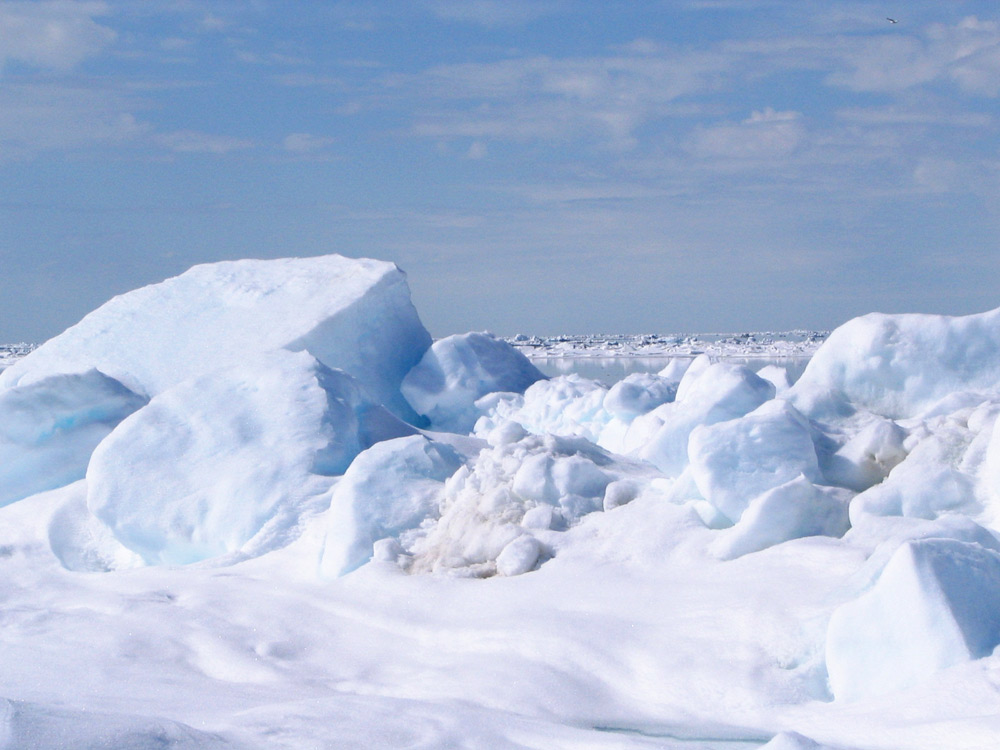
Our planet has gone through extreme climate change in the past.
Photo: NOAA.
Evidence of these temperature changes has come from analysis of radioisotopes, fossils, plankton, ocean sediments, and tiny bubbles in ice cores. Additional evidence has come from pollen found at the bottom of lakes, tree rings, bat dung in caves, and temperature records collected since 1861.
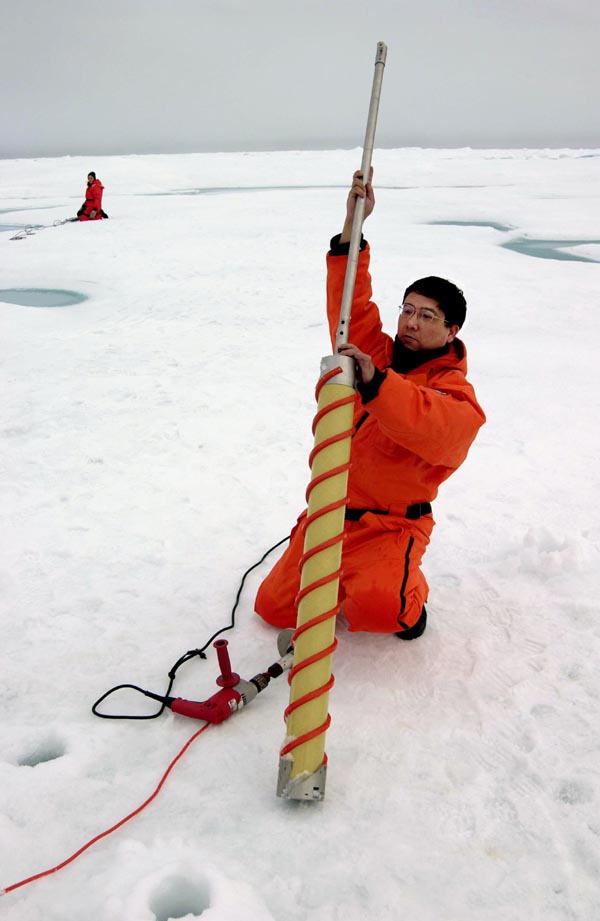
An ice core is being removed by a NOAA scientist.
Photo: NOAA
Interestingly we need the greenhouse effect to maintain the temperatures within a range for us to survive. The Swedish scientist Svante Arrhenius first explained this greenhouse effect in 1896. Solar radiation penetrates our atmosphere and warms the surface of the earth. Hot air generated from this surface heating rises but is trapped by a layer gas that includes carbon dioxide, methane, and water vapor. These gases act as a greenhouse allowing light through but trapping the rising heated air. Hence, they are known as greenhouse gases. Without this natural greenhouse layer, the planet would be too cold for us to live here.

The greenhouse effect.
Image: NOAA
The industrial revolution began about 300 years ago. The burning of fossil fuels, and loss of photosynthetic trees due to deforestation, resulted in significant increases in these greenhouse gases. According to a 2007 study, if CO2 emissions continue to increase at a rate of 3.3% each year, we will reach CO2 concentrations near 560 parts per million by 2050 and could reach levels near 1,390 ppm by 2100. At the time this was stated, 2011, scientific studies and models suggested we should prevent CO2 from exceeding 450 ppm. Going beyond this we might exceed a tipping point that could trigger climate change impacts for centuries. NOTE: NOAA published in 2023 that the atmospheric CO2 concentration was 419 ppm.
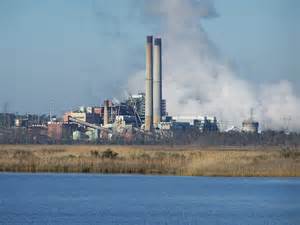
Power plant on one of the panhandle estuaries.
Photo: Flickr
In 1988 the United Nations and the World Meteorological Organization established the Intergovernmental Panel on Climate Change (IPPC) to review past climate changes and predict future ones. This network included over 2500 climate experts from 130 countries. In their 2007 report they stated…
- It is very likely (90-99% probability) that the lower atmosphere is warming.
- Human activities are responsible for this.
Evidence used for these statements include:
- Between 1906-2005 the mean global surface temperature had risen 1.3°F. Most of the increase had taken place SINCE 1980.
- Annual greenhouse gases emissions from human activity have risen 70% between 1970 and 2005. Average CO2 emissions were higher than they have been in 650,000 years.
- Since 1960 Arctic temperatures have risen twice as fast as the rest of the planet.
- In some parts of the world glaciers and sea ice were melting, rainfall patterns were changing, and prolonged droughts were on the rise.
- During the 20th century sea levels rose between 4-8 inches.
Data in 2011 showed that the melting of ice in the Arctic had increased since the 2007 IPPC report. One scientist, Allan Robock, stated that the ice was melting at a faster rate than their computer models said it would.
What is the scientific consensus about future temperature change?
- It is very likely (90-99% probability) that human activities are the cause of the recent increase. Particularly the burning of fossil fuels.
- It is very likely (90-99% probability) the earth’s mean surface temperature will increase 3.6-8.1°F between 2005 and 2100. NOTE: Since 2005 the rate of warming has doubled. In one year (2023) the mean temperature of the planet increased 1.44°F – the largest annual increase in 144 years. This was partially due to being an El Nino year.
In 2011 there was the question as to whether the oceans could help absorb CO2 from the atmosphere. At that time the ocean was absorbing between 25-30% of the CO2 emitted by humans. However, the solubility of CO2 in the oceans decreases with increasing water temperatures. As the oceans warm some of the dissolved CO2 would be re-released into the atmosphere and could amplify global warming and climate change. At that time, the oceans had warmed between 0.6-1.2°F during the 20th century. According to a 2007 study the oceans were absorbing less CO2 than they had in the past. NOTE: A 2017 study indicated that mean sea surface temperatures of the oceans have increased 0.22°F since 2000. This is twice as fast as the early models predicted.
The consensus is that the warming predicted by the computer models used at the time is occurring and – in some cases – faster than they thought.
In Part 3 we will look at what they thought some of the possible effects of this warming trend could be and whether any of those predictions have actually happened.
References
Miller, G.T., Spoolman, S.E. 2011. Living in the Environment; Concepts, Connections, and Solutions. 16th Edition. Brooks and Cole. Belmont CA. 674 pp.
Lindsey R. 2024. Climate Change: Atmospheric Carbon Dioxide. NOAA Climate. https://www.climate.gov/news-features/understanding-climate/climate-change-atmospheric-carbon-dioxide.

by Rick O'Connor | Jun 21, 2024
Many from the “baby boomer” generation, which includes me, can probably tell you weather patterns have changed since we were kids. Growing up in Pensacola I remember the pattern of a typical summer day. It would be sunny in the morning, when most of us would get out and do our daily activities, whatever those might have been. The land breezes would shift to sea breeze around noon and by mid afternoon there would be a thunderstorm. These storms generally passed quickly and were followed by a sunny, but cooler afternoon with wonderful sunsets. Most summer days were like this. During winter we generally had frost on the ground – at least three days a week. Again, those who grew up with this I am sure have noticed – it has changed.

In the past people would enjoy the beach in the mornings before the daily afternoon thunderstorm.
Photo: Rick O’Connor
Our summer days now seem to be periods of several long hot days with little or no rain at all. When rain does come it seems to be intense, it could last all day and may occur for several days in a row. We will go through periods of intense rain followed by days of all most drought conditions. The days seem to be hotter. If you watch the news, we are continually breaking temperature records. The same could be said about rainy days, there have been several “100-year flood” events in the past decade. Hurricanes were once things we dealt with once in a decade, we now seem to be in the “cone of uncertainty” of some storm each season.
In addition to the changes with weather have come changes with coastal plants and animals. Mangroves, snook, and bone fish – all once thought of as “south Florida species” are now appearing along the Florida panhandle. Manatee encounters are increasing and the threat of invasive species – which once was not an issue due to our colder winters – is something we now must look at. It is changing. As we observe these changes, I often get the question – “is this due to climate change?”

Black mangroves growing near St. George Island in Franklin County.
Photo: Joshua Hodson.
In the 1990s I taught environmental science at Pensacola State College and AP Environmental Science at Washington High School. Climate change was a topic we covered and discussed the latest science behind the topic. I still have the textbook I taught from and thought it might be interesting to look back at what was being said at the time and whether the predictions given were actually happening. The chapter on climate change began with a case study. It provided the following:
In June of 1991 the active volcano Mount Pinatubo in the Philippines erupted. The eruption released ash and compounds 22 miles up into the atmosphere. Hot gases and ash rolled down the mountain side killing hundreds of people and filling valleys with toxic materials. It destroyed communities and caused hundreds of millions of dollars’ worth of damage. Despite the horrific impact it also provided scientists with an opportunity.
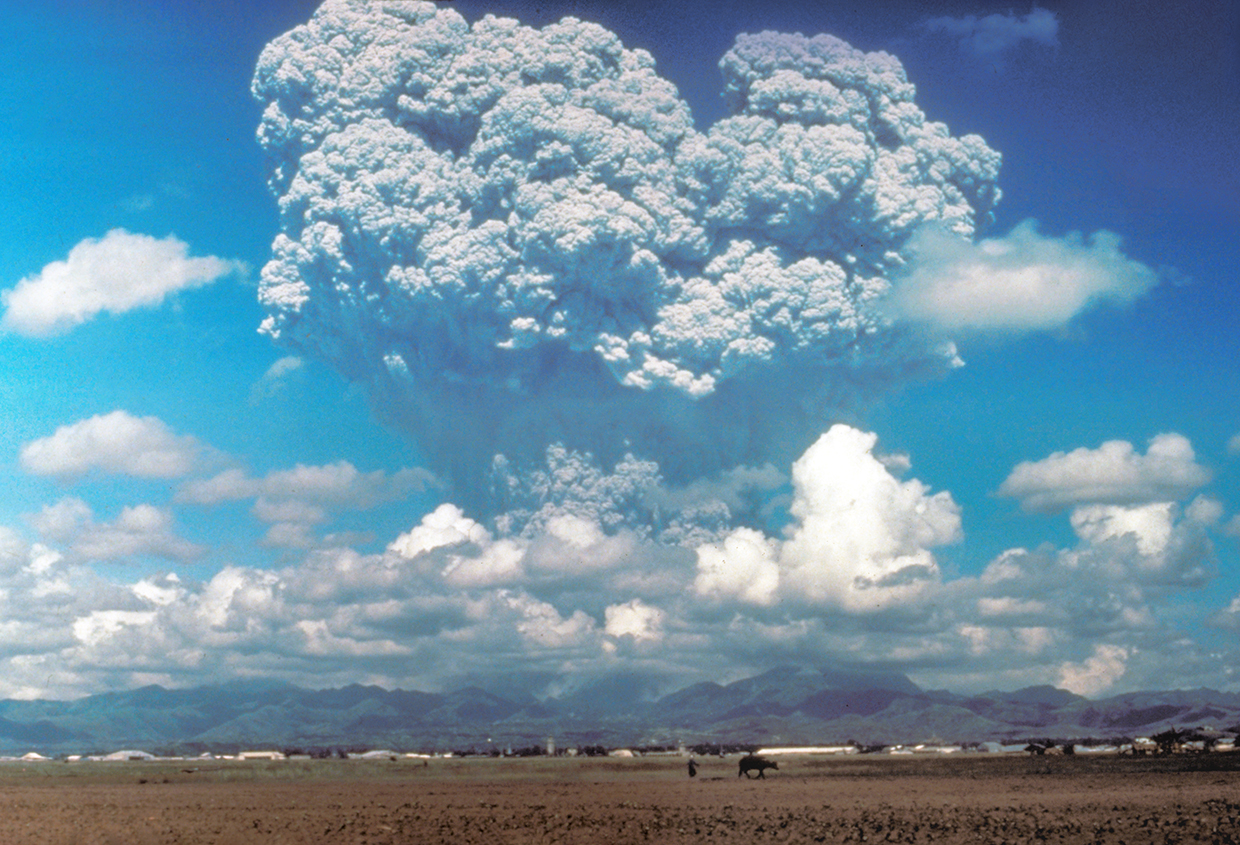
The eruption of Mt. Pinatubo.
Photo: NOAA
Climate scientists had been monitoring global warming for a couple of decades at that point and had developed computer models that could predict both the change of climate in the future (if such warming trends continued) and what impacts these changes may have. But unlike the computer models used to predict the course and landfalls of hurricanes, they had no way of testing them. But with the eruption of Mt. Pinatubo, the opportunity was there.
Based on such models, James Hansen, a NASA scientist at the time, predicted the volcanic eruption would first cool the planet 1°F over a 19-month period and then begin to warm. He predicted that by 1995 temperatures would return to normal. His predictions proved correct. The model had passed the test. This case helped convince most scientists and policy makers that climate model projections should be taken seriously.
Hansen’s model, and 18 other climate models, indicated that global temperatures were likely to rise several degrees during the century – mostly due to human actions – and affect global and regional climates and economies.
Over the next few weeks, we will post a series of articles looking at what was discussed decades ago and see whether the weather patterns we are experiencing match the predictions we discussed in class at that time. We will take another look at climate change.
Part 2 – How Might the Earth’s Temperature and Climate Change in the Future?

by Rick O'Connor | Nov 4, 2021
In this series we have looked at where the concept of climate change came from and how climate has changed over the centuries. We looked closer at the changes over the last decade and what the most recent IPCC report is telling us. We also looked at how changes have impacted Florida and the panhandle specifically. Much of the news is concerning to many and the outlook for the rest of the century paints a picture of climate problems we will have to deal with. But hope is not lost. Based on the 2021 AR6 report, even if we stop all greenhouse gas emissions today, the sea will rise – we have missed that tipping point and will have to plan for that. But there are other areas where our communities can make changes to help turn this thing around. In Part 5 we will look at potential solutions and specifically focus on where individuals like you and I can make changes that can help.

Photo: Molly O’Connor
Where do you start?
As G.T. Miller states in his book Living in the Environment1 it is going to be tough. It is a global problem and will take many nations to agree to make things happen. We know how hard that can be. It is also a political problem, and we know that can be hard as well. It is also affecting some regions of the planet more than others and thus some will be more concerned and ready to act, while others do not see the need to spend resources on the issue. Miller states there are two basic plans of attack on this – (1) reduce greenhouse gas emissions, or (2) try and mitigate the impacts.
During the 1970s Dr. William Rathje developed a program at the University of Arizona called Garbology. One of the objectives of the program was to determine what humans throw away in order to determine what the “big players” were in reducing solid waste going to the landfill1. They were able to develop a pie chart showing what items made up the material we call garbage and then developed a plan to reduce those “big players”. Let’s take the same approach with reducing greenhouse gases. What are the sources of these gases? Who are the “big players” so that we know where to direct our efforts to significantly reduce emissions and curtail some of the possible problems predicted by the models?
According to a 2021 EPA report, carbon dioxide (CO2) makes up 76% of the global greenhouse gas emissions2. This would be an obvious gas to target significant reductions. 86% of the carbon dioxide comes from the burning of fossil fuels, a more specific target for reduction and a good starting point.
| Percentage of Greenhouse Gas Emissions |
Gas |
Source |
| 65% |
Carbon dioxide (CO2) |
Fossil Fuels |
| 16% |
Methane (CH4) |
Waste, Biomass energy |
| 11% |
Carbon dioxide (CO2) |
Deforestation, Agriculture, and Soil degradation |
| 6% |
Nitrous oxide (N2O) |
Fertilizer use |
| 2% |
Fluorinated gases |
Industrial processing, Refrigerators, and some consumer products |
Source: U.S. Environmental Protection Agency
So, where are fossil fuels being burned?
Where can we begin to discuss reductions there?
The same US EPA report breaks down the economic sectors where greenhouse gases are being produced on a global scale. A second report focuses on those same sectors but from the United States3. The table below compares these two.
| Global Economic Sector |
Percent |
U.S. Economic Sector |
Percent |
| Electricity and Heat Production |
25% |
Transportation |
29% |
| Agriculture and Forestry activities |
24% |
Electricity and Heat Production |
25% |
| Industry |
21% |
Industry |
23% |
| Transportation |
14% |
Commercial and Residential use |
13% |
| Other Energy Sources |
10% |
Land Use and Forestry activities |
12%1 |
|
|
Agriculture |
10% |
Source: U.S. Environmental Protection Agency
noted that total my not round to 100% due to independent rounding
Comparing the greenhouse gas emissions of U.S. economic sectors to those of the world shows a few things.
- Electricity and heat production is a major producer of GHG and a good target for reduction.
- Transportation is a larger problem in the U.S., in fact it is the number one problem.
- Agriculture and forestry are larger problems on the global scale, less of one in the U.S.
- Commercial and residential use is a larger problem than agriculture and forestry in the U.S., it was not even reported on a global scale.
Now we know who the “big players” are. Can we do anything about these?
Reducing emissions from electricity and heat production will have to come from our leaders. At the time of this writing, the United Nations Climate Summit is going in Scotland and much discussion about this is going on. China, Russia, and India are all concerned about reducing GHG from coal powered plants. This is understandable being that this is the major source of energy for those nations. However, the negative impact of burning coal on the climate is serious and cannot be ignored if the world is serious about reducing, or eliminating, the long-term impacts of climate change. So, the move away from coal is a good start.
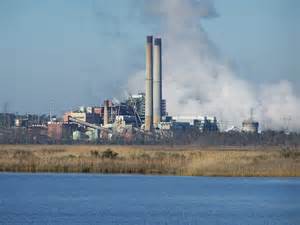
Power plant on one of the panhandle estuaries.
Photo: Flickr
The EPA reported in 2019 that United States has seen a decrease in greenhouse gas emissions primarily due to a decrease in energy use and the decrease in the use of coal – showing it can be done3. The United States is discussing reducing the use of coal even further, but not all in congress support this – primarily those who represent states where coal mining is a large industry. But again, the negative impacts of burning coal are there and, if the world wants to “turn this thing around”, we will need to consider doing this. Again, there is little the citizen can do to make these changes other than selecting leaders who are willing to. It is in their hands.
The transportation issue is different… we can make a difference here.
In the U.S. transportation produces 29% of the greenhouse gas emissions, #1. It is only 14% of the problem worldwide. Americans love their cars. We drive everywhere. Most Americans live at least 25 miles from where they work, many live much further, some actually live in a different state. Being work, most of these drivers are traveling alone, carpooling is not a common practice, and mass transit is not available in many communities. So, we sit in traffic jams every morning and evening trying to get to the places we want, and need, and complain of the congestion, wishing the local government could improve traffic flow. One of the reasons we have this problem, and other parts of the world do not, is how we design our cities.

Heavy traffic is common place in the U.S. with our dependence on cars.
Photo: Rick O’Connor
Some city planners argue the best way to reduce the transportation issue is by compact development. This is a plan that would have residents live within walking or biking distance of everything they need – home, work, stores, etc. Our ancestors lived this way primarily because they had to, they did not have cars. The wealthy, who had horse and carriage, could live outside of town and ride in when they wanted.
This desire to live outside of the city in more open space could be used in another form of urban development that could still reduce the transportation problem – satellite development. In this method, residents would live in suburb areas that were connected to the urban workplace by mass transit. Imagine living in a suburb where you went to the rail station, climbed on, and traveled over greenspaces (supporting forest and pasture lands) to the urban work area. There are many cities in the U.S. who have this type of system in place, but few travel over greenspaces – they mostly travel over other suburban developments.
However, this would generate crowds at the terminal and the stress that comes with it. It would make it harder to “stop by the store” on the way home – though the stores would be within walking distance in the residential “satellite” area. Walt Disney promoted this idea when he was planning Epcot and used the monorail as an example of how it could be done.
But we love our cars… so, another plan would be what is called corridor development. Here, people would live in the residential satellite suburbs but rather than mass transit into the city, there would be a “freeway” for cars to use. Freeway in this sense meaning nothing but highway… no traffic lights, no stores, nothing the impede traffic until you get there. Think in terms of our interstate system. There are many examples of this design around the country. Even here close to home, highway 98 was diverted around Destin to avoid traffic jams. The idea was there would be a clear road around if you were traveling through. But as we will see, in most cases, this did not work.

Heavy urban development “sprawls” away from the city in many U.S. communities. The “corridor” to work has become congested.
Photo: Rick O’Connor
In most cases we plan a corridor design but along the “freeway” route we build new residential developments – they want stores closer and so strip malls and other commercial developments spring up – these residents and businesses need access to the “freeway”, so traffic lights go up and now the city has basically moved away from the central hub into the suburbs forming what we call a megalopolis. I bet this scenario sounds very familiar. It is happening everywhere – even here in the Pensacola area.
Urban sprawl is a big problem and only makes the transportation issue a larger one. G.T. Miller Jr. mentions that urban sprawl is occurring because
- There is affordable land to do so
- We have automobiles so we can function in the design
- Gasoline is cheap
- And we do not plan our cities well
So, we live in a car dominated society – traveling everywhere – usually alone.
Can we do anything about this?
Many scientists and economists believe the only way to reduce the transportation problem is to make it expensive to use. It is believed that making gasoline more expensive would force many to change their driving habits. Currently gas prices are moving towards $4.00 / gallon. We have seen this before and the driving practices did not change much. Some economists believe you will not see such changes until gas reaches $5.00 or $6.00 / gallon – a price many other developed nations routinely spend. It will be interesting to see.

How high will gas prices have to go before U.S. transportation behaviors change?
Photo: Rick O’Connor
Another idea on the cost side is a gasoline tax to cover the estimated harmful costs of driving. The funds from such taxes could be used to develop mass transit systems, bike lanes, and sidewalks. This is occurring in other parts of the world but would probably not work in the United States. Miller gives three reasons why it would be a hard sell in the United States.
- There would be opposition to any tax.
- Fast, efficient, reliable, and affordable mass transit systems and bike lanes are not widely available in most U.S. communities
- The way our communities are designed… we need cars
Other suggested financial methods would include raising parking fees within the city, and more toll roads.
But while we wait and see where gas prices will go and when people will make changes in their driving habits, is there anything else we could do?
Yes…
Carpooling has been suggested since the 1970s. It does occur but has not caught on as many had hoped. Within our community here in Pensacola there are several “park and ride” parking lots and there usually cars in them.

This carpool parking lot near Pensacola is completely full. Indicating more use of this service.
Photo: Rick O’Connor

Carpooling is one method to reduce fuel use and GHG emissions.
Photo: Rick O’Connor
There has been an increase interest in hybrid and electric cars in recent years. One concern for electric was the ability to pull heavy loads, something Americans will require. In just the past year one major auto maker began promoting an all-electric truck they assure has the pulling power of a similar size gas powered truck. One colleague of mine recently bought an all-electric jeep which he assured me has plenty of power to pull. More electric charge stations are appearing in local communities, and it seems this is an option for many.
It was also noted in the EPA report that changing our driving habits (i.e., fast starts, incorrect tire pressure, etc.) does make a difference. I know we have all seen the driver who is speeding – darting in and out of traffic only to be at the same stop light with all others in the end. So, changing HOW we drive can help as well.
As mentioned, agriculture and forestry are not as big of an issue in the U.S. as it is on a global scale. There are numerous BMPs farmers can use to reduce their carbon footprint and restore the natural carbon-sequestration. Most not only help with reducing GHG but save the farmers money. There are financial incentives for them to participate in these BMP programs – and so many farmers are using these BMPs. But none-the-less there are things we can still do in this area.
- Support local farmers who are participating in BMP programs by purchasing their products where/when you can. On a global scale the negative impacts of agriculture are increasing. You may have to do a little homework to see where our farmers are selling their products, but it is good to support their efforts.
- Plant a tree… though our forestry industry is making improvements, many communities are clearing land to expand development. Many of these developments are clearing ALL of the trees and putting few back afterwards. Planting a tree not only helps sequester carbon it has been found that shade from trees can lower internal house temperatures up to 10°F, saving heating and cooling costs as well as the energy needed for these1.

Author and county forester Cathy Hardin demonstrates proper tree planting at a past Arbor Day program. Photo credit: Carrie Stevenson, UF IFAS Extension
And then there is commercial and residential energy use. Something that did not even make it on a global scale.
How can we reduce energy use at home and at work?
There are plenty of ways and we need to consider them. According to the EPA report, energy use in the residential and commercial sector is increasing, not decreasing3.
Let’s begin with smart buildings…
Our home was struck by lighting in 2013 and we rebuilt using as many energy efficient methods as we could. Spray foam insultation, better windows, energy efficient appliances, LED lighting, metal roof, and setting the thermostat smarter have all worked well for us. We are typically billed less than $200 per month for our electricity – and there is more we can do. Your local utility company, and your county extension office, can give you numerous tips on how you can save energy in your home or office.
The 2019 EPA report suggests that greenhouse gas emissions are increasing in the areas of transportation, residential and commercial use, and some agriculture practices. But they are decreasing in energy production, industrial processing, and forestry activities. So, we know we can do this. We just need to step up and do it.
References
1 Miller Jr., G.T., S.E. Spoolman. 2011. Living in the Environment; Concepts, Connections, and Solutions. 17th edition. Brooks and Cole Publishing. Belmont CA. pp. 674.
2 Sources of Greenhouse Emissions. 2021. Global Greenhouse Gas Emissions Data. United States Environmental Protection Agency.
https://www.epa.gov/ghgemissions/global-greenhouse-gas-emissions-data.
3 Sources of Greenhouse Emissions. 2019. U.S. Greenhouse Gas Emissions Data. United States Environmental Protection Agency.
https://www.epa.gov/ghgemissions/sources-greenhouse-gas-emissions



















